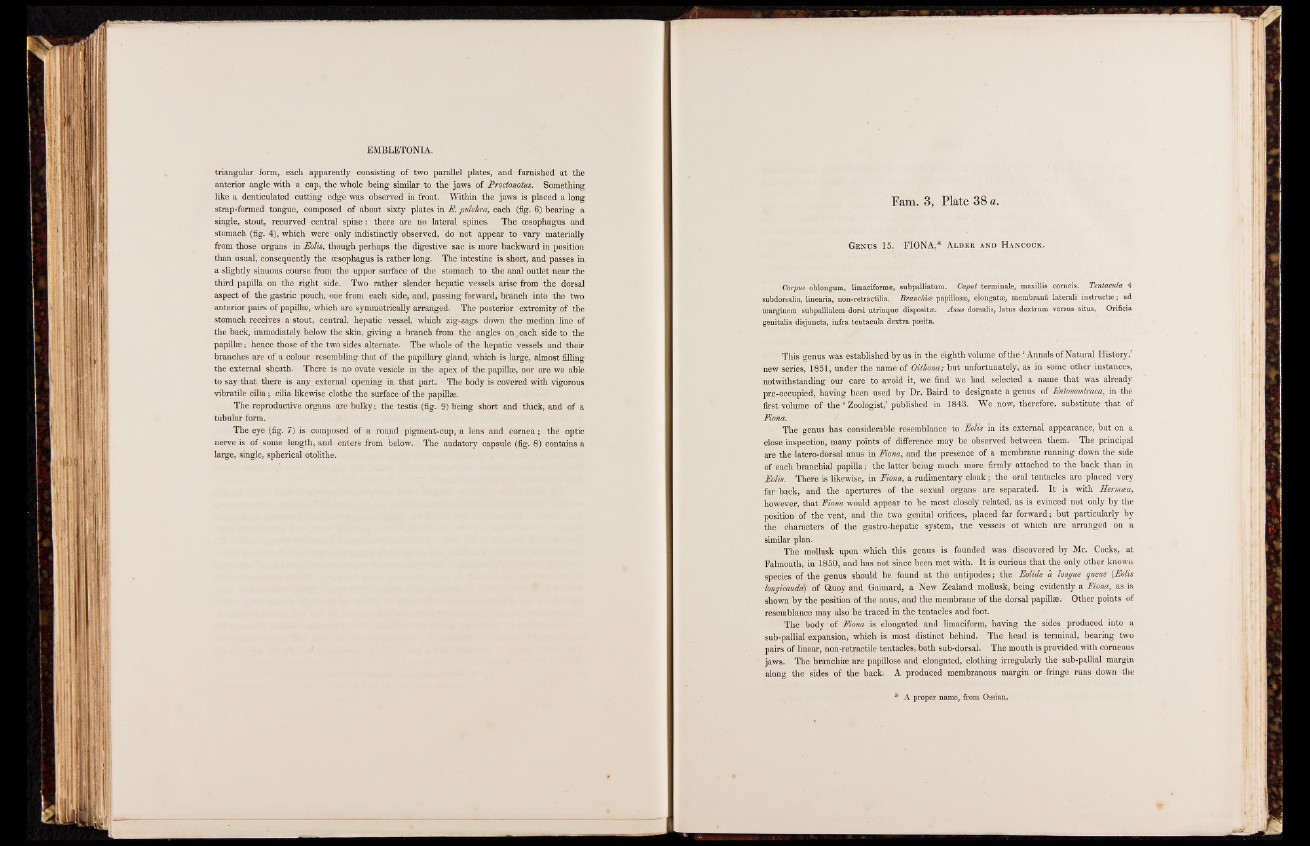
triangular form, each apparently consisting of two parallel plates, and furnished at the
anterior angle with a cap, the whole being similar to the jaws of Proclonotm. Something
like a denticulated cutting edge was observed in front. Within the jaws is placed a long
strap-formed tongue, composed of about sixty plates in E.pulchra, each (fig. 6) bearing a
single, stout, recurved central spine: there are no lateral spines. The (esophagus and
stomach (fig. 4), which were only indistinctly observed, do not appear to vary materially
from those organs in Eolis, though perhaps the digestive sac is more backward in position
than usual, consequently the oesophagus is rather long. The intestine is short, and passes in
a slightly sinuous course from the upper surface of the stomach to the anal outlet near the
third papilla on the right side. Two rather slender hepatic vessels arise from the dorsal
aspect of the gastric pouch, one from each side, and, passing forward, branch into the two
anterior pairs of papillae, which are symmetrically arranged. The posterior extremity of the
stomach receives a stout, central, hepatic vessel, which zig-zags down the median line of
the back, immediately below the skin, giving a branch from the angles on,each side to the
papillae; hence those of the two sides alternate. The whole of the hepatic vessels and their
branches are of a colour resembling that of the papillary gland, which is large, almost filling
the external sheath. There is no ovate vesicle in the apex of the papillae, nor are we able
to say that there is any external opening in that part. The body is covered with vigorous
vibratile cilia ; cilia likewise clothe the surface of the papillae.
The reproductive organs are bulky; the testis (fig. 9) being short and thick, and of a
tubular form.
The eye (fig. 7) is composed of a round pigment-cup, a lens and cornea; the optic
nerve is of some length, and enters from below. The audatory capsule (fig. 8) contains a
large, single, spherical otolithe.
Fam. 3, Plate 38«.
Genus 15. FIONA,* Alder and Hancock.
Corpus oblongum, limaciforme, subpalliatum. Caput terminale, maxillis corneis. Tentacula 4
subdorsalia, linearia, non-retractilia. Branchice papillosse, elongatse, membranä laterali instructs;; ad
marginetn subpallialem dorsi utrinque dispositse. Anus dorsalis, latus dextrum versus situs. Orificia
genitalia disjuncta, infra tentacula dextra posita.
This genus was established by us in the eighth volume of the ‘ Annals of Natural History,’
new series, 1851, under the name of Oithona; but unfortunately, as in some other instances;
notwithstanding our care to avoid it, we find we had selected a name that was already
pre-occupied, having been used by Dr. Baird to designate a genus of Fktomostraca, in the
first volume of the ‘ Zoologist,’ published in 1843. We now, therefore, substitute that of
Mona.
The genus has considerable resemblance to Eolis in its external appearance, but on a
close inspection, many points of difference may be observed between them. The principal
are the latero-dorsal anus in Fiona, and the presence of a membrane running down the side
of each branchial papilla; the latter being much more firmly attached to the back than in
Eolis. There is likewise, in Fiona, a rudimentary cloak; the oral tentacles are placed very
far back, and the apertures of the sexual organs are separated. It is with Hermeea,
however, that Fiona would appear to be most closely related, as is evinced not only by the
position of the vent, and the two genital orifices, placed far forward; but particularly by
the characters of the gastro-hepatic system, the vessels of which are arranged on a
similar plan.
The mollusk upon which this genus is founded was discovered by Mr. Cocks, at
Falmouth, in 1850, and has not since been met with. It is curious that the only other known
species of the genus should be found at the antipodes; the Eolide a longue queue {Eolis
longicauda) of Q,uoy and Gaimard, a New Zealand mollusk, being evidently a Fiona, as is
shown by the position of the anus, and the membrane of the dorsal papillae. Other points of
resemblance may also be traced in the tentacles and foot.
The body of Mona is elongated and limaciform, having the sides produced into a
sub-pallial expansion, which is most distinct behind. The head is terminal, bearing two
pairs of linear, non-retractile tentacles, both sub-dorsal. The mouth is provided with corneous
jaws. The branchiae are papillose and elongated, clothing irregularly the sub-pallial margin
along the sides of the back. A produced membranous margin or fringe runs down the
* A proper name, from Ossian.